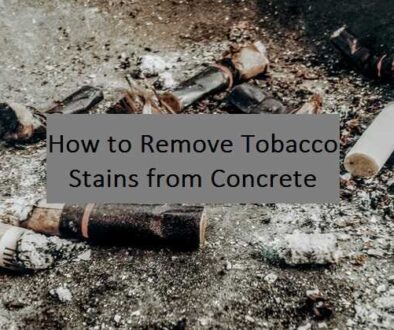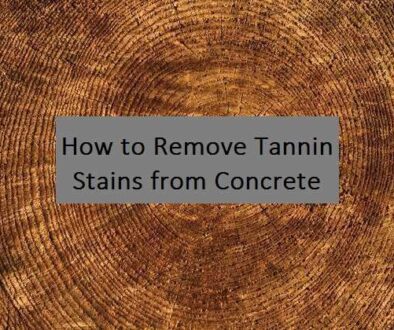How to Remove Paint from Concrete

Last updated on March 24th, 2023
Renovating or remolding your house with new paint can give it a fresh, clean, and decorative look. However, with improper preparation and protection of the surrounding bare concrete surfaces, paint can stick to and stain those surfaces. In fact, this issue is quite common, and many contractors and home owners look for different methods to clean and remove paint spills from concrete.
In this article, we will address comprehensive methods and techniques, taking into consideration the different conditions of paint spills.
Time matters
When dealing with paint on concrete surfaces, time is a major factor. In particular, fresh or wet spills require a different approach than dry paint. Usually, most fresh spills are easier to remove especially when you take immediate action. Accordingly, we will address fresh and dry paint separately.
How to remove fresh paint from concrete

In general, it is important to take immediate action for fresh paint spills in order to limit their spread and degree of staining. However, the process of dealing with fresh paint stains largely depends on whether the paint is water based or oil based. Thereby, we will address each condition separately.
Water based fresh paint pills
Things you will need
- Absorptive cloth / paper towels.
- Gloves.
- Scouring powder.
- Bristle brush / scouring pad.
- Clean water.
Notes
- Scouring powder or abrasive powder.
Appearance: Usually white powder, but can come in different colors.
Availability: It available at the supermarkets and cleaning supply stores.
Hazards: Can be corrosive to flesh.
Procedure
- Use a clean absorptive cloth or paper towels to gently, without wiping, soak up the excess surface paint.
- Put on safety gloves.
- Scrub the spot gently with abrasive or scouring powder using bristle brush or scouring pad.
- Rinse with clean water.
- Repeat steps 2 and 3 as needed, until the process becomes ineffective.
- Allow the remaining stain, if any, to dry out for 3 days.
- Follow the dry paint removal method for the remaining stain.
Explanation
As soon as the spill occurs, you should use an absorptive cloth or paper towels to soak up as much paint as possible. It is important not to rub or wipe the spill, as this can further spread and push the paint into the surface. Instead, gently place the cloth or paper towels and let the absorption take its course.
Then, wear safety gloves and apply scouring powder to the spot and gently scrub using a bristle brush or scouring pad. Next, rinse the surface with clean water and check the results. Sometimes, this process can be sufficient to remove the spill completely, but not always. This mainly depends on the type of paint, surface condition and porosity, temperature, and time. Accordingly, you can repeat gentle scrubbing and rinsing until you can achieve no further improvement. In fact, this process is effective for the removal of the paint film, but not much for the penetrated paint which can actually cause the stain. Finally, if any stain remains, allow it to dry out for 3 days, then follow the dry paint removal method.
Oil based fresh paint pills
Things you will need
- Absorptive cloth / paper towels.
Procedure
- Gently soak up as much paint as possible using an absorptive cloth or paper towels, without wiping.
- Let the remains dry out for 3 days.
- Follow the dry paint removal method.
Explanation
Dealing with fresh oil based paint stains is different from those of water based. Basically, all you have to do is to soak up as much paint as possible, and wait for the remains to dry out for three days before applying a dry paint removal method. Besides, it is important to note that you should not wipe or rub the surface when soaking up the spill.
Note: Do not try to remove fresh paint stains from concrete using a solvent, as this may promote the paint to penetrate deeper into the surface and spread wider.
How to remove dry paint from concrete

Dry paint on concrete surfaces can vary in its toughness, and can sometimes be challenging to completely remove with one method. Accordingly, we will address a comprehensive cleaning method, which includes different techniques and various stages depending on the toughness of the paint stain.
Things you will need
- Bristle brush / scouring pad.
- Scraper – depending on the condition of the dry paint.
- Safety gear**.
- Paint remover / TSP / Sodium Hydroxide / alcohol.
- Talc powder / sawdust / car litter – for poultice*.
- Water.
- Scouring powder.
- Pressure washer / hot air gun*.
- Abrasive media*.
- Soda*.
- Grinder*.
- Hydrochloric acid*.
- Neutralizer / baking soda*.
- Benzene*.
- Plastic sheet*.
- Detergent*.
* Material might not be needed depending on the cleaning method.
** Safety gear depends on the materials and methods.
Notes
- Scouring powder or abrasive powder.
Appearance: Usually white powder, but can come in various colors.
Availability: It available at the supermarkets and cleaning supply stores.
Hazards: Can be corrosive to flesh. - Paint remover or paint stripper.
Appearance: Usually gel, varies in color.
Availability: It available at hardware and paint supply stores.
Hazards: Varies – depending on the composition. - Trisodium Phosphate: Other names include Sodium Orthophosphate, TSP, or Phosphate of Soda.
Appearance: White crystalline odorless powder.
Availability: It is available at the supermarkets.
Hazards: This compound is corrosive to flesh. - Sodium Hydroxide: Other names include Caustic Soda and Lye.
Appearance: White crystalline powder.
Availability: It is available at chemical and cleaning supply stores.
Hazards: It is corrosive and irritating. - Alcohol.
Appearance: Clear liquid.
Availability: It is available at supermarkets and pharmaceutical supply stores.
Hazards: Irritant and flammable. - Hydrochloric Acid or Muriatic Acid.
Appearance: Colorless liquid.
Availability: It is available at chemical or pool supply stores.
Hazards: Highly corrosive, toxic, reacts vigorously with ammonia.
Note: Always add acid to water and not water to acid. - Benzene: Other names include Benzol or Coal Naphtha.
Appearance: Colorless liquid.
Availability: It is available at chemical, hardware, and paint stores.
Hazards: This compound is highly flammable, toxic, and carcinogenic. - Laundry detergents can be corrosive to flesh, and cause irritations.
Procedure
- Scrape off using a bristle brush or a scraper depending on the condition of the dry paint stain.
- Put on your safety gear.
- Apply one of the following to loosen the film:
- Paint remover. Make sure to follow the manufacturer’s instructions.
Note: Select a paint remover which does not contain toxic chemicals (such as methylene chloride which is used in traditional paint strippers). Instead look for “friendlier” products, which generally contain formic acid, and that are specifically designed to work for the type of paint you are removing. - TSP aqueous solution.
- 1 part sodium hydroxide to 3.5 parts hot water by weight as a solution or poultice.
- Alcohol poultice, for shellac.
- Paint remover. Make sure to follow the manufacturer’s instructions.
- Gently scrub using a bristle brush to loosen the film.
- Rinse and flush thoroughly with clean water.
Any remaining or more stubborn films may require one of the following methods

- Scrubbing with an abrasive or scouring powder.
- Medium pressure washing.
- Burning with a hot air gun (more effective on oil based paint). Then scrape off using a bristle brush.
Note: Do not use the burning method to remove paint stain for paints which contain lead, as this can produce toxic fumes. - Pressure washing while adding an abrasive media.
Note: Pressure washing with an abrasive media can affect the appearance. - Soda Blasting.
- Grinding.
Any remaining stains or penetrated paint may require one of the following methods

- Applying
an acidic solution
- Pre-wet
the surface (saturated with no free surface water).
- Apply
a 1:10 hydrochloric acid to water solution.
- Scrub
gently using a bristle brush.
- Rinse
the surface thoroughly with clean water.
- Neutralize
the surface with baking soda and water at 5-8% dosage.
- Rinse
and flush thoroughly.
Note: The time period between applying the acidic solution and neutralizing the surface should be limited to 10 minutes.
Use a more diluted acidic solution for decorative colored concrete, and test on a small area first since this can affect texture and color.
2. Applying a poultice
- Prepare
a poultice with talc and benzene to form a thick paste.
- Apply
the paste to the spot.
- Cover
with plastic sheet.
- After
the poultice dries, remove the cover, and scrape off the remains using a
bristle brush.
- Scrub
the surface with warm water and detergent.
- Rinse
and flush thoroughly.
Explanation
This procedure for the removal of dry paint from concrete is comprehensive, and includes various chemical and mechanical methods to deal with stubborn paint films and stains. In brief, we divided this procedure into three stages: the first for the removal of typical dry paint from concrete, the second for the removal of stubborn films, and the third for the removal of stubborn paint stains. However, the toughness of a dry paint on concrete can vary. Thereby, you might not need to apply all these stages.
Frequently asked questions
Will vinegar remove paint from concrete?
Yes, vinegar can be effective in removing tough paint stains from concrete surfaces, mainly due to its acidity. However, you should be careful not to etch the surface, just as the use of other acidic solutions such as hydrochloric acid.
How to remove paint from concrete without chemicals?
Removing paint from concrete without the use of chemicals include mechanical methods such as pressure washing, sanding, soda blasting, and grinding.




